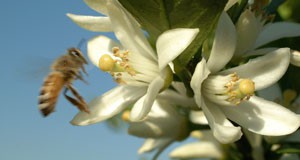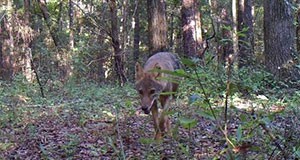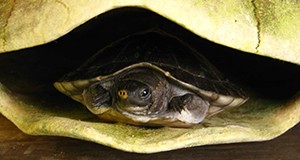Pollinator insects are essential to world food crop production, the economy, and the environment. Neonicotinoid (neonic) insecticides are facing intense backlash from environmental groups because the systemic protection they provide throughout the plant, including the pollen and nectar, may be injuring pollinator insects and causing their population decline. But many nursery and greenhouse growers use neonic-based pesticide control measures because they are effective, inexpensive, and cause less environmental damage than other insecticides. The increased publicity may influence consumer demand and preferences but very few studies have investigated consumer responses to neonic-free labels, and evidence suggests that many consumers have little knowledge or awareness of the issue. This 3-page fact sheet describes the results of a the study investigating how consumers’ awareness of neonic insecticides influenced their preferences and purchasing behavior for plants and exploring the marketing potential of using alternate pollinator promotions (besides neonic-free) in garden center retail outlets. Written by Hayk Khachatryan and published by the Food and Resource Economics Department.
http://edis.ifas.ufl.edu/fe991
Category: Ecosystems & Species
Hydrilla: Florida's Worst Submersed Weed
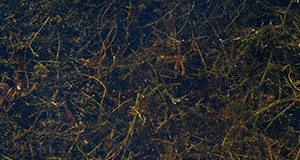
Hydrilla, which was originally introduced to the state as an aquarium plant, was intentionally planted in canals by aquarium plant dealers in the 1950s and quickly escaped cultivation. In addition to being one of the world’s worst aquatic weeds, the species is Florida’s most intensively managed submersed plant. Hydrilla is a federally listed noxious weed and a prohibited aquatic plant in Florida, making cultivation, sale, and possession of the species illegal. This 7-page fact sheet discusses the classification, characteristics, habitat, and management of hydrilla. Written by Lyn A. Gettys and Stephen F. Enloe, and published by the UF Agronomy Department, February 2016.
http://edis.ifas.ufl.edu/ag404
New and Revised Featured Creatures, April 2016
Biology, Control and Invasive Potential of Giant Reed (Arundo donax L.) in Florida
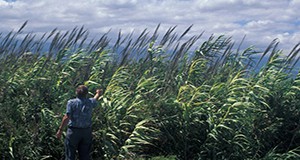
Arundo donax (L.), also known as giant reed, is a tall, fast-growing, bamboo-like grass that under ideal conditions can reach a height of up to 30 feet and a stem diameter up to 1.5 inches. Giant reed is invasive and difficult to control and has caused economic losses in California, Nevada, Utah, Arizona, New Mexico, and Texas. This species was introduced to Florida over 100 years ago and is currently naturalized in at least 26 of the 67 Florida counties. So far giant reed has not proved problematic in Florida, but recent permitting of its planting for bioenergy feed stock may increase the risk that it could naturalize into plant communities in Florida and other southeastern states and potentially cause economic losses as well as harm to native species and habitats. This 5-page fact sheet written by Pat Minogue and Seth Wright and published by the School of Forest Resources and Conservation describes the biology of this species and explains some strategies for its control.
edis.ifas.ufl.edu/fr396
The Green-Spore Poison Parasol Mushroom,Chlorophyllum molybdites
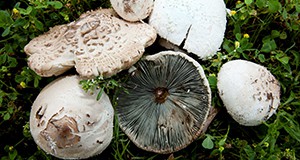
The “false parasol” or “green-spored parasol” mushroom (Chlorophyllum molybdites) is a poisonous mushroom that is the most common cause of mushroom poisoning in the United States. This mushroom is widely distributed throughout Florida and the southeastern United States. It commonly creates a complete or incomplete “fairy ring” in lawns, grassy areas, and open woods. When mature, the green-spored parasol mushroom has a large cap, a ring around its stem, and a greenish color on the underside of its gills. This four-page fact sheet describes the morphology, ecology, and distribution of the green-spored mushroom as well as its toxicology and how to treat poisoning from this mushroom. Written by Lisbeth Espinoza and Matthew E. Smith, and published by the Plant Pathology department.
http://edis.ifas.ufl.edu/pp324
New & Revised Featured Creatures Publications
- Paper Wasp, Red Wasp (Suggested Common Names) Polistes carolina (L.) (Insecta: Hymenoptera: Vespidae)
- Broad-Tipped Conehead Katydid (suggested common name) Neoconocephalus triops (Linnaeus, 1758) (Orthoptera: Tettigoniidae: Conocephalinae)
- Viburnum Leaf Beetle Pyrrhalta viburni (Paykull) (Insecta: Coleoptera: Chrysomelidae)
- Strawberry Leafroller Ancylis comptana (Frölich) (Insecta: Lepidoptera: Tortricidae)
- Stable Fly Stomoxys calcitrans (L.) (Insecta: Diptera: Muscidae)
Rancher Perceptions of the Coyote in Florida
Throughout the continental United States and large portions of Canada and Central America, changes people make to the landscape such as the clearing of forested land and the extermination of larger predators like gray and red wolves have made the environment perfect for the adaptive coyote. Coyotes have rapidly taken advantage of these environmental shifts and expanded into new areas, now including all 67 counties in Florida and even Key Largo. Each year more people in Florida catch a glimpse of a coyote crossing a road or running across open fields, or notice coyote scat along a hiking trail–and farmers and ranchers are seeing signs of coyotes on their farms.
As coyotes become a fixture of the Florida landscape, potential grows for conflict with humans. Coyotes are in Florida to stay, and understanding the agricultural community’s perception of their influence on livestock and wildlife is important to developing effective policies for coyote management. This 4-page fact sheet written by Raoul K. Boughton, Bethany Wight, and Martin B. Main and published by the Wildlife Ecology and Conservation Department provides results of ongoing statewide surveys of ranchers in Florida regarding the influence of coyotes on their operations.
Native Aquatic and Wetland Plants: Duck Potato, Sagittaria lancifolia
 This 3-page fact sheet discusses the classification, description, habitat, propagation, and uses of duck potato, an aquatic perennial that typically grows in swampy ground or standing water in ponds, lakes, streams, and ditches and usually blooms in the spring. Written by Kimberly A. Moore, Luci E. Fisher, Carl J. Della Torre III, and Lyn A. Gettys, and published by the UF Department of Agronomy, December 2015.
This 3-page fact sheet discusses the classification, description, habitat, propagation, and uses of duck potato, an aquatic perennial that typically grows in swampy ground or standing water in ponds, lakes, streams, and ditches and usually blooms in the spring. Written by Kimberly A. Moore, Luci E. Fisher, Carl J. Della Torre III, and Lyn A. Gettys, and published by the UF Department of Agronomy, December 2015.
http://edis.ifas.ufl.edu/ag403
Native Aquatic and Wetland Plants: Cardinal Flower, Lobelia cardinalis
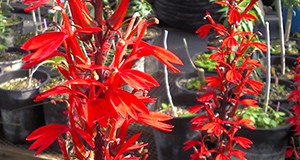 This 3-page fact sheet discusses the classification, description, habitat, propagation, and use of cardinal flower, an aquatic perennial that is commonly found in stream banks and swamps. Written by Kimberly A. Moore, Luci E. Fisher, Carl J. Della Torre III, and Lyn A. Gettys, and published by the UF Department of Agronomy, December 2015.
This 3-page fact sheet discusses the classification, description, habitat, propagation, and use of cardinal flower, an aquatic perennial that is commonly found in stream banks and swamps. Written by Kimberly A. Moore, Luci E. Fisher, Carl J. Della Torre III, and Lyn A. Gettys, and published by the UF Department of Agronomy, December 2015.
http://edis.ifas.ufl.edu/ag402
Native Aquatic and Wetland Plants: Blue-Eyed Grass, Sisyrinchium angustifolium
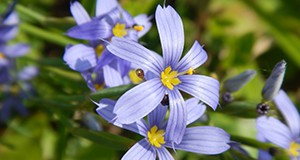 This 2-page fact sheet discusses the classification, description, habitat, propagation, and uses of blue-eyed grass, an aquatic perennial native to Florida. Written by Kimberly A. Moore, Luci E. Fisher, Carl J. Della Torre III, and Lyn A. Gettys, and published by the UF Department of Agronomy, December 2015.
This 2-page fact sheet discusses the classification, description, habitat, propagation, and uses of blue-eyed grass, an aquatic perennial native to Florida. Written by Kimberly A. Moore, Luci E. Fisher, Carl J. Della Torre III, and Lyn A. Gettys, and published by the UF Department of Agronomy, December 2015.
http://edis.ifas.ufl.edu/ag401
Zika, a Mosquito-Transmitted Virus
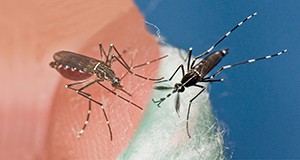
Zika is a mosquito-transmitted virus that has spread broadly in tropical regions and caused epidemics, especially in the past 8 to 9 years. In its native range in West Africa and Uganda, the Zika virus stays in the forest for the most part, and human infections are considered incidental and medically inconsequential. In 2015, however, Zika became a larger concern when a strain of the virus traced to outbreaks in French Polynesia emerged in northeastern Brazil. This strain provoked alarm because of increased incidence of microcephaly in babies born to Zika-infected mothers. Local transmission, mainly by the yellow fever mosquito Aedes aegypti, has now been documented in most tropical countries of the Americas but has not yet been detected in the continental United States. This 7-page fact sheet written by L. P. Lounibos, B. W. Alto, N. D. Burkett-Cadena, C. C. Lord, C. T. Smartt, C. R. Connelly, and J. R. Rey and published by the Department of Entomology and Nematology describes the Zika microbe, its mosquito hosts, and the disease it causes. A history of the virus and its migration are included, along with some details about the virus in the state of Florida and preventative measures people can take to avoid infection. The best way to avoid contracting Zika (and other mosquito-borne diseases) is not to get bitten in the first place. Take precautions to avoid mosquito bites.
http://edis.ifas.ufl.edu/in1120
See also 2/9/2016 press release:UF/IFAS scientists write document explaining Zika virus; urge vigilance.
El Zika, un Virus Transmitido por Mosquitos

Zika es un virus transmitido por mosquitos que se ha esparcido recientemente en regiones tropicales y ha causado epidemias, especialmente durante los últimos 8 o 9 años. En su ámbito nativo en África Occidental y Uganda, el virus se mantiene en los bosques, circulando entre mosquitos que viven en huecos de árboles y primates arbóreos; las infecciones de humanos se consideran incidentales y de poca importancia médica. Una cepa del virus que se implicó en brotes en Polinesia Francesa emergió en el Norte de Brasil en el 2015 y causó gran consternación debido a la alta incidencia de microcefalia en bebes nacidos de madres que fueron infectadas con el virus durante la gestación. Transmisión local, principalmente por el mosquito de la fiebre amarilla Aedes aegypti, ha sido documentada en la mayoría de los países tropicales de las Américas, pero aún no se ha detectado en Los Estados Unidos Continentales. Los síntomas de la infección incluyen, salpullido, dolor de cabeza, fiebre, dolor muscular y en las coyunturas, conjuntivitis, y malestar general.
This 7-page fact sheet written by J. R. Rey, L. P. Lounibos, B. W. Alto, N. D. Burkett-Cadena, C. C. Lord, C. T. Smartt, and C. R. Connelly and published by the Department of Entomology and Nematology is the Spanish language version of Zika, a Mosquito-Transmitted Virus and describes the Zika microbe, its mosquito hosts, and the disease it causes. A history of the virus and its migration are included, along with some details about the virus in the state of Florida and preventative measures people can take to avoid infection. The best way to avoid contracting Zika (and other mosquito-borne diseases) is not to get bitten in the first place. Take precautions to avoid mosquito bites.
http://edis.ifas.ufl.edu/in1121
Safe Harbor Agreement: A Regulatory Assurance under the Endangered Species Act
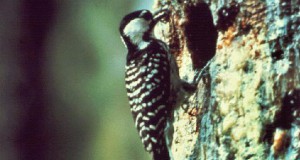
The involvement of the private sector is critical for the conservation and recovery of many species, but landowners’ fears that increased management restrictions could keep them from enjoying their land can present a challenge to securing their trust and assistance in conservation efforts. A Safe Harbor Agreement is a regulatory assurance that removes the risk of additional regulation in the future and encourages landowners to maintain important habitat on their lands. This three-page publication written by Melissa M. Kreye, Elizabeth F. Pienaar, Raoul K. Boughton, and Lindsey Wiggins and published by the Wildlife Ecology and Conservation Department provides Extension agents, decision-makers, and landowners with a basic understanding of a landowner’s obligations and the benefits of enrolling.
http://edis.ifas.ufl.edu/uw403
Arrow Arum: Peltandra virginica
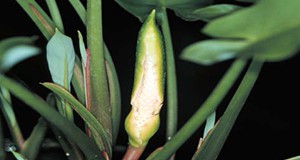 Arrow arum is a native aquatic and wetland plant that is a welcome addition to water gardens, aquatic ponds, and wetland restoration and mitigation sites. The species is broadly adapted and extremely common throughout Florida, and its perennial nature assures a stellar performance year after year. This new 3-page fact sheet provides an overview of this plant and discusses its distribution, habitat, propagation, and other uses. Written by Kimberly A. Moore, Luci E. Fisher, Carl J. Della Torre III, and Lyn A. Gettys, and published by the UF Department of Agronomy, October 2015.
Arrow arum is a native aquatic and wetland plant that is a welcome addition to water gardens, aquatic ponds, and wetland restoration and mitigation sites. The species is broadly adapted and extremely common throughout Florida, and its perennial nature assures a stellar performance year after year. This new 3-page fact sheet provides an overview of this plant and discusses its distribution, habitat, propagation, and other uses. Written by Kimberly A. Moore, Luci E. Fisher, Carl J. Della Torre III, and Lyn A. Gettys, and published by the UF Department of Agronomy, October 2015.
http://edis.ifas.ufl.edu/ag400
Frequently Asked Questions about Vibrio in Florida
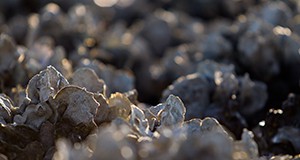
Florida is a tropical paradise that attracts marine enthusiasts and seafood lovers from around the world. Its extensive waterways not only offer unique areas for us to explore but also provide essential habitat for marine life, including marine bacteria that keep the habitat in healthy balance by breaking down organic matter and providing food for larger organisms. One type of marine bacteria known as Vibrio sometimes causes infections and seafood sickness in people with weakened immune systems, but Vibrio should not keep Floridians and visitors from enjoying their favorite activities because Vibrio infections are rare and easy to prevent. This 7-page fact sheet written by Gabby Barbarite, Peter J McCarthy, Holly Abeels, and Anita Wrightwill and published by the Florida Sea Grant College Program will help you ensure that your time on the water is as safe and enjoyable as possible.
http://edis.ifas.ufl.edu/SG140
The Argentine Black and White Tegu in South Florida: Population Growth, Spread, and Containment

Florida is home to more nonnative species of reptiles and amphibians than anywhere else in the world because of its subtropical climate, large areas of disturbed habitats, and thriving trade in exotic pets. Although pythons have received the majority of public attention, invasive lizards also pose a significant threat to south Florida’s native wildlife and ecosystems, and a good example is the Argentine black and white tegu. Learn more about this exotic lizard in this 3-page fact sheet written by Rebecca G. Harvey and Frank J. Mazzotti and published by the Wildlife Ecology and Conservation Department.
http://edis.ifas.ufl.edu/uw405
The Social Organization of Honey Bees

A honey bee colony is a superorganism, which means that together its members function like a single animal. Bees within a colony work together like the cells in a human body. They warm the colony in the winter by vibrating their wings to generate heat and cool it in the summer by ferrying in droplets of water and fanning air over them. Worker bees fan air into and out of the colony entrance in distinct inhalations and exhalations. Colonies reproduce by swarming to create new daughter colonies that in turn thermoregulate, breathe, and reproduce just as a single autonomous animal does. In three pages this fact sheet explains the intricate caste system and age-based division of labor that allows colonies of humankind’s best-loved pollinators to function and thrive. Written by Ashley N. Mortensen, Bryan Smith, and James D. Ellis and published by the Entomology and Nematology Department.
http://edis.ifas.ufl.edu/in1102
Biology of the Hicatee: A Critically Endangered River Turtle of Belize
The hicatee (Dermatemys mawii) is a Central American river turtle and one of the 25 most endangered turtle species in the world. Over-hunting for meat, eggs, and shells is driving the turtles toward extinction. This 3-page fact sheet about the hicatee includes its natural history, reproductive habits, and ecology and describes the international conservation efforts to save the fascinating but fast-disappearing turtle. Written by Venetia Briggs-Gonzalez, Nathan Schwartz, Rebecca G. Harvey, and Frank J. Mazzotti and published in November 2015 by the Wildlife Ecology and Conservation Department.
http://edis.ifas.ufl.edu/uw404
New Featured Creature publications added
The following publications are now available in EDIS:
Released November 9:
- Spicebush Swallowtail Papilio (Pterourus) Troilus Linnaeus 1758
- Lesser Wax Moth Achroia grisella Fabricius
- Oblong-Winged Katydid (suggested common name) Amblycorypha oblongifolia
- Florida Flower Thrips (suggested common name) Frankliniella bispinosa Morgan
- Laurelcherry Smoky Moth, Neoprocris floridana Tarmann 1984
- Pineapple Mealybug, Dysmicoccus brevipes (Cockerell)
Released November 10:
- Laurelcherry Smoky Moth, Neoprocris floridana Tarmann 1984
- Pineapple Mealybug, Dysmicoccus brevipes (Cockerell)
These publications on EDIS are alternate versions of pages published first on the Featured Creatures website.
Creeping Indigo, A Poisonous Plant of Concern in Florida Pastures
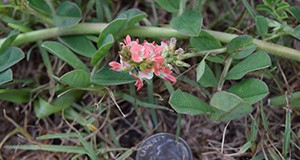 A recent rise in suspected horse poisonings has brought new attention to creeping indigo (Indigofera spicata), a toxic plant which has reportedly been in Florida for as long as 90 years. This new 5-page fact sheet covers plant description, signs of creeping indigo toxicity, and roles of creeping indigo’s toxins, as well as treatment and management. Written by Robert MacKay, Ed Jennings, Brent Sellers, Jason Ferrell, and Amanda House, and published by the UF Department of Agronomy, August 2015.
A recent rise in suspected horse poisonings has brought new attention to creeping indigo (Indigofera spicata), a toxic plant which has reportedly been in Florida for as long as 90 years. This new 5-page fact sheet covers plant description, signs of creeping indigo toxicity, and roles of creeping indigo’s toxins, as well as treatment and management. Written by Robert MacKay, Ed Jennings, Brent Sellers, Jason Ferrell, and Amanda House, and published by the UF Department of Agronomy, August 2015.
http://edis.ifas.ufl.edu/ag399
